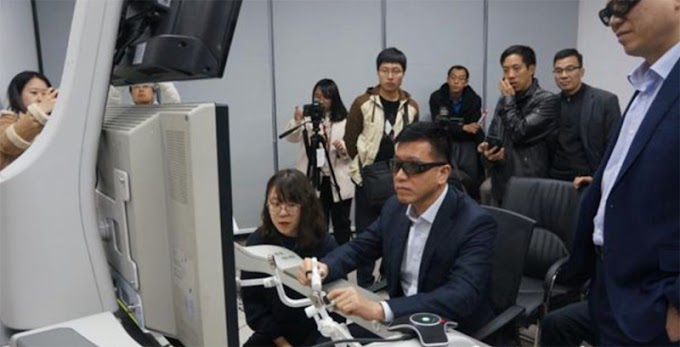Who
doesn’t love Tony Stark in the movie Iron man? Who himself build an ‘arc
reactor’ that powers the popular ‘Suite’ in the movie scenes? Now the point is
where did the idea come from? The idea is an old or rather fundamental one.
This is the only process by which starts to continue to live for millions of
years. The quest for nuclear fusion started back in 1926 when British
astrophysicist Arthur Eddington suggested that stars draw their energy from the
fusion of hydrogen into helium. To replicate the fusion process in the Earth,
scientists from the Soviet Union devised a way in which the thermonuclear
reaction could be confined into a magnetic field. They called it ‘magnetic
confinement fusion device’, the ‘tokamak’. So, What is ‘tokamak’?
 |
| The iron man wearing a fictional Fusion device 'arc reactor' in his chest Pic courtesy: pixabay |
What is nuclear fusion?
To
answer the question, we must understand the way nuclear Fusion happens at the
core of every star. There exists a very strong repulsive force between two or
more atomic nuclei, but somehow if they are managed to fuse, an enormous amount
of energy is generated which radiates in form of heat and light energy that we
see and feel every daytime. Now the question is how they are going to fuse?
Well, naturally in the core of stars, due to the heavy temperature, the atomic
nuclei start to get a velocity near to the speed of light, that velocity helps
them to overcome nuclear repulsion. For example, if 4 natural hydrogen atoms get fused it generates a Helium-4 (4He2). But what is strange is that the
mass of a single Helium atom is 99.2% of 4 Hydrogen atoms before fusion. This
indicates the 0.8% mass of the Hydrogen atoms has been converted into pure
energy according to famous Einstein’s relation E = mc2, where m is the energy
equivalent mass (0.8% here). So, a very tiny mass could give us an unimaginable
amount of energy without generating any harmful isotopes as by-products unlike
Its brother nasty ‘Nuclear Fission’ does. To get a glimpse of what amount of
energy is generated one can refer to the 1st fusion bomb ‘Ivy Mike’ detonated
by the US in 1952. Moreover, fusion generates heavier elements from lighter
atoms, which is also responsible for the generation of heavier elements in the
universe. In that aspect, we are also proof of nuclear fusion.
 |
| 4 Hydrogen atoms are fused together to generate Helium atom inside the sun pic courtesy: Wikipedia |
How to replicate natural fusion in the Earth?
Nuclear
fusion can give us the ultimate source of energy no doubt without many impacts
in terms of by-products that it generates. If it has commercially become
available, would be the most important treasure trove for humanity. One of the
ways is to create ‘sun-like environment in the earth’. Which is done by
confining a very hot plasma within a very strong magnetic field. What does it
mean? It means the orange color that we see in the sun is the plasma that is
one of the 4th states of matter that is generated when a nuclear fusion
reaction happens inside the sun. Plasma is a stream of ionized particles, also
being ions, they can be controlled by magnetic fields. But creating a plasma in
natural earthly conditions is not going to work. For that, some special
magnetic coils are required. When a current is passed through a magnetic coil
it generates a magnetic field that we have studied in school days. Let us bring
our imagination on step further and create a magnetic toroid, and concentrate
inside the toroid where the magnetic field is strongest. This is the place
where a super-hot plasma can be confined. That’s why every nuclear fusion
experiment ridiculously complex and large.
Trials for nuclear fusion:
By 1950s, researchers started looking at possibilities of replicating the process
of nuclear fusion on Earth. And in 1950 the tokamak was invented. This was
followed, by Lyman Spitzer's concept for the stellarator in 1951. The
stellarator concept dominated fusion research throughout the 1950s but lost its
way when the experimental research on tokamak systems showed that the tokamak
was a more efficient concept. Before the 1950s, U.S., UK, and USSR kept fusion
research secret, However, by the mid-1950s administrators and scientists alike
were convinced that controlled fusion research had no military applications,
and in particular had nothing to do with the development of thermonuclear
weapons. It was becoming clear by 1970 that attaining fusion energy would be
one of science's greatest challenges and collaboration might be key to meeting
the challenge. In 1973 European countries came together and began design work
on the Joint European Torus, JET. First, worldwide collaboration took place, as
a result of Reagan–Gorbachev initiative at Geneva Summit in 1985 with the equal
participation of the Soviet Union, the European Atomic Energy Community, the
United States, and Japan. The project began with the name of the International
Thermonuclear Experimental Reactor (ITER). Later on, China, South Korea, and
India (in 2005) became members of the ITER project. In the same year (2005), it
was officially announced that ITER would be built in the European Union in
Saint-Paul-Les-Durance, some 35 km north of Aix-en-Provence in southern France.
Although the construction of the ITER tokamak complex started in 2013 it is
expected to be completed by 2025, Initial plasma experiments are scheduled to
begin in 2025, with full deuterium-tritium fusion experiments starting in 2035.
 |
| The ITER nuclear fusion project, pic courtesy: EUROfusion, |
India’s contribution to fusion research:
The
research and development in thermonuclear fusion are lead by the Institute for
Plasma Research (IPR), an autonomous R & D organization under the authority
of the Department of Atomic Energy (DAE) near west banks of river Sabarmati in
Gujarat. Under IPR two ‘tokamak’ machine is operating, they are ‘ADITYA’ &
‘Steady State Tokamak (SST) – 1’. Both of them are operating towards the stable
& sustained generation of plasma, which is extremely important for the
fusion process.
Also,
IPR is providing the cryostat, a 30-meter diameter, equally tall
stainless-steel vessel which envelops the entire basic systems of the tokamak
and is a vacuum-tight container in the ITER project located in France. India is
one of the countries is going to provide 9% funding of the total ITER
project which is expected to start producing plasma by 2025.
 |
| Completion of Manufacturing of In-Wall Shield for ITER pic courtesy: http://dae.gov.in/node/1390 |
Conclusion:
Worldwide research of
fusion has been started, most importantly some private organizations are also
involved in finding a way for commercially viable nuclear fusion reactors. In
terms of status, most of the organization has created plasma but it can’t
sustain much to provide a space for actual fusion. As a result, the efficiency
of the process is not good. To have a better future every country has to cut
down carbon emissions to 0% within 1 or 2 decades. Otherwise, the way Earth is
warming up it will not be favorable for us. On a different note, the planetary
journeys will only be possible if we can construct a successful fusion device. Which
is under the intermediate stage of research and development. It has to evolve
much more before any fusion device comes commercially. If not, ‘star war’s’ starships will remain science fiction.




0 Comments
All non-spamy comments will be visible